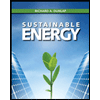
Engineering Fundamentals: An Introduction to Engineering (MindTap Course List)
5th Edition
ISBN: 9781305084766
Author: Saeed Moaveni
Publisher: Cengage Learning
expand_more
expand_more
format_list_bulleted
Concept explainers
Question
Chapter 13, Problem 12P
To determine
Find the electrical energy consumed by the unit in 1hour and cost to run air-conditioning unit for a month (31 days) and its coefficient of performance (COP).
Expert Solution & Answer
Trending nowThis is a popular solution!

Students have asked these similar questions
Please solve the example, explaining the solution steps and writing by hand
Please solve the example, explaining the solution steps and writing by hand
Note: (please show handwritten answers, and no AI usage !)
Provide a clear, step-by-step handwritten solution (without any detailed explanations). Ensure the work is simplified and completed manually, adhering to expert-level accuracy. Refer to the provided image for clarity and ensure all calculations are double-checked for correctness before submission. Thank you!.
Question 1:
A cylindrical soil sample is connected to two water reservoirs:
a) Determine the pressure, elevation, and total head at a point one meter above the bottom of the sample (point A).
b) Calculate the pore pressure and effective stress at point A if the soil has a saturated unit weight of 18.7kN/m^3. c) Determine the water flow rate though the sample if the soil has a coefficient of permeability of 0.19 cm/s and the radius of the sample is 20 mm.
d) Is it possible for the soil to reach the “quick condition”(zero effective stress) by raising the level of the water in the upper reservoir? Why or why not?.
Question…
Chapter 13 Solutions
Engineering Fundamentals: An Introduction to Engineering (MindTap Course List)
Ch. 13.2 - Prob. 1BYGCh. 13.2 - Prob. 2BYGCh. 13.2 - Prob. 3BYGCh. 13.2 - Prob. 4BYGCh. 13.2 - Prob. 5BYGCh. 13.2 - Prob. BYGVCh. 13.4 - Prob. 1BYGCh. 13.4 - Prob. 2BYGCh. 13.4 - Prob. 3BYGCh. 13.4 - Prob. 4BYG
Ch. 13.4 - Prob. BYGVCh. 13.5 - Prob. 1BYGCh. 13.5 - Prob. 2BYGCh. 13.5 - Prob. 3BYGCh. 13.5 - Prob. 4BYGCh. 13.5 - Prob. 5BYGCh. 13.5 - Prob. BYGVCh. 13 - Prob. 1PCh. 13 - Prob. 2PCh. 13 - An elevator has a rated capacity of 2200 lb. It...Ch. 13 - Prob. 4PCh. 13 - Prob. 5PCh. 13 - Prob. 6PCh. 13 - Prob. 7PCh. 13 - Prob. 8PCh. 13 - Prob. 9PCh. 13 - Prob. 10PCh. 13 - Prob. 12PCh. 13 - Prob. 14PCh. 13 - Prob. 15PCh. 13 - Prob. 16PCh. 13 - Prob. 17PCh. 13 - Prob. 18PCh. 13 - Prob. 19PCh. 13 - Prob. 20PCh. 13 - Prob. 22PCh. 13 - Prob. 23PCh. 13 - Prob. 24PCh. 13 - Prob. 25PCh. 13 - Prob. 26P
Knowledge Booster
Learn more about
Need a deep-dive on the concept behind this application? Look no further. Learn more about this topic, civil-engineering and related others by exploring similar questions and additional content below.Similar questions
- Note: Please provide a clear, step-by-step simplified handwritten working out (no explanations!), ensuring it is done without any AI involvement. I require an expert-level answer, and I will assess and rate based on the quality and accuracy of your work and refer to the provided image for more clarity. Make sure to double-check everything for correctness before submitting thanks!. Questions 1: A clay rich soil is totally saturated, has a bulk density of 2.12 g/cm3, and a void ratio of 0.33. a) Draw the full three phase diagram for this soil including all the volume and mass quantities. b) Determine the density of the soil solids. c) Determine the total density of the soil if the saturation was reduced to 50%. Question 2: A soil sample was tested yielding the following grain-size distribution chart: (refer to the image provided) The soil fines (inorganic) were also tested and had a liquid limit of 76 and a plastic limit of 49 Determine the coefficients of uniformity and curvature.…arrow_forwardNote: Provide a clear, step-by-step handwritten solution (without any detailed explanations). Ensure the work is simplified and completed manually, adhering to expert-level accuracy. Refer to the provided image for clarity and ensure all calculations are double-checked for correctness before submission. Thank you!. Question 1: A cylindrical soil sample is connected to two water reservoirs: a) Determine the pressure, elevation, and total head at a point one meter above the bottom of the sample (point A). b) Calculate the pore pressure and effective stress at point A if the soil has a saturated unit weight of 18.7kN/m^3. c) Determine the water flow rate though the sample if the soil has a coefficient of permeability of 0.19 cm/s and the radius of the sample is 20 mm. d) Is it possible for the soil to reach the “quick condition”(zero effective stress) by raising the level of the water in the upper reservoir? Why or why not?. Question 2: A new structure is planned to be constructed in…arrow_forwardNote: Provide a clear, step-by-step, simplified handwritten solution (no explanations), ensuring it is completed without any AI involvement. The solution must demonstrate expert-level accuracy and will be evaluated for its quality and precision. Please refer to the provided image for additional clarity. Double-check all calculations for correctness before submission. Thank you!. Question 1: (refer to the image for visual understanding) For the soil element shown on the right: a) Draw the Mohr’s circle for this case b) Find the major and minor principal stresses c) Find the normal and shear stresses on plane AB. Question 2: (refer to the image) A soil sample in a triaxial test with a cell pressure of 100 kPa fails when the vertical stress reaches 400 kPa. The resulting failureplane is observed to dip 60 degrees from horizontal (see figure). Assume that the soil is drained during the test, i.e. there is no pore pressure. a) Determine the friction angle of the soil. Hint: draw the…arrow_forward
- Please solve all pointsarrow_forward1: find out the optimal solution: 1- Reliability Function 2- Serial Configuration 3- M.T.T.F 4- Probability distribution function (P.D.F) 5- Failure rate function :calculate the reliability of the system for the following Figure 0.90 0.80 0.95 0.80 0.80 0.94) 0.80 : A system containing four connected compounds in series, each one has a distribution and its parameters as shown in the table below Component Scale parameter Shape parameter 1 100 1.20 2 150 0.87 3 510 - 1.80 4 720 1.00arrow_forwardTime: 1. Hrs During the last ten days: In one of the productive operations, the electronic control calculator equipped with No. of defects for a specific volume of samples as shown: 10 9 8 7 6 5 4 3 2 1 Day No. 6673 6976 7505 6991 7028 6960 7916 7010 6591 7350 Total No. 53 55 60 58 16 22 49 48 64 17 Defect No. DRAW THAT & CHOOSE THE BEST A-P chart. B-C chart 1. Key functions of quality control include: A) Control of design, materials received and products and conduct studies of operations B-Design and develop reasonable specifications C) The use of equipment that gives the required accuracy D) Provide appropriate screening equipment 2. The basic principles of critical pathways are: A-fragmentation of the system to the objectives of the secondary clear and specific B-Drawing the network diagram C-Finding the critical path D- All of the above 3- The production system is the following: A-An integral part of the plant's completion B-An effective system to integrate the efforts of various…arrow_forward
- ) We started a new production process and its study gave the total deviations The standard value (for 25 samples of the product, sample size 4) is .105 .Calculate the capacity of this process The product specification limits are: 6.30 = LSL 6.50 = USL Standard deviation in a manufacturing system is 0.038 = We made improvements to the system and the deviation has become Standard 0.030 = σ What is required is to calculate the estimated coefficient before and after the operation Optimization. What is your conclusion? : A find out the optimal solution: 1-Average Outgoing Quality AOQ 2- operating Characteristics Curve 100% Inspection 3-Acceptable Quality level 4- Average outgoing Quality AOQ 5- Capability Index CPKarrow_forwardFollowing are the data of gauge and discharge collected at a particular section of the river by stream gauging operation. Gauge reading Discharge Gauge reading Discharge (m) (cms) (m) (cms) 7.65 15 8.48 170 7.70 30 8.98 400 7.77 57 9.30 600 7.80 39 9.50 800 7.90 60 89 10.50 1500 7.91 100 11.10 2000 8.08 150 11.70 2400 1. Develop a rating curve for this stream at this section for use in estimating the discharge for a known gauge reading and fit a linear regression equation for use in estimation of stage for a known value of discharge. Use a value of 7.50 as the gauge reading corresponding to zero discharge. (20 pts) Equation 1 arith 2. What is the coefficient of correlation of the derived relationship? (10 pts) R2² arith Equation 2 log R2 log 3. Determine the stage for a discharge of 3500 cms (5 pts) 4. Determine the discharge for a stage of 15 m (5 pts) NB Do both arithmetic and logarithmic plotsarrow_forwardQ2/ A (2m x 4 m) rectangular flexible foundation is placed above the ground surface (G.S) for two layers of clay, each layer 10 m thick. The modulus of Elasticity (E.) of the upper layer is 13 MN/m² and that of the lower layer is 15 MN/m². The Poisson ratio is (u, = 0.6) for the two layers. The pressure (stress) of 100 kN/m²is distributed along the surface of foundation. Determine the rigid immediate settlement at the corner of the foundation using Elastic theory method?arrow_forward
arrow_back_ios
SEE MORE QUESTIONS
arrow_forward_ios
Recommended textbooks for you

 Engineering Fundamentals: An Introduction to Engi...Civil EngineeringISBN:9781305084766Author:Saeed MoaveniPublisher:Cengage Learning
Engineering Fundamentals: An Introduction to Engi...Civil EngineeringISBN:9781305084766Author:Saeed MoaveniPublisher:Cengage Learning Sustainable EnergyCivil EngineeringISBN:9781133108689Author:Richard A. DunlapPublisher:Cengage Learning
Sustainable EnergyCivil EngineeringISBN:9781133108689Author:Richard A. DunlapPublisher:Cengage Learning


Engineering Fundamentals: An Introduction to Engi...
Civil Engineering
ISBN:9781305084766
Author:Saeed Moaveni
Publisher:Cengage Learning

Sustainable Energy
Civil Engineering
ISBN:9781133108689
Author:Richard A. Dunlap
Publisher:Cengage Learning